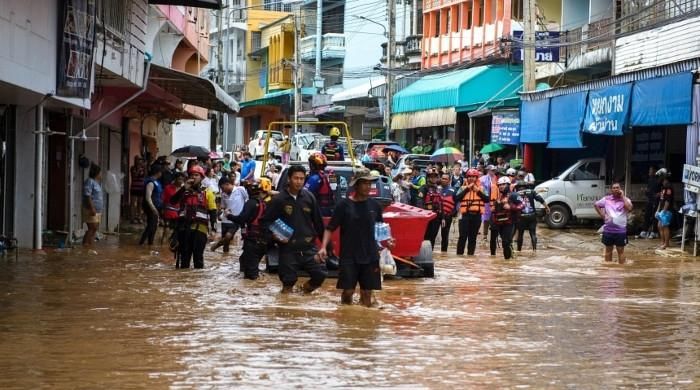HANOI: Millions of people across Southeast Asia were battling flooded homes, power outages and destroyed infrastructure on Thursday after Typhoon Yagi tore through the region, with the death toll rising above 200.
In Vietnam, the worst-hit country, the death toll rose to 197, with nine confirmed deaths in northern Thailand, where one district is experiencing its worst flooding in 80 years.
Volcano Yagi struck Vietnam over the weekend, unleashing a colossal deluge of rain that inundated a swathe of northern Vietnam, Laos, Thailand and Myanmar, triggering deadly landslides and widespread river flooding.
A farmer said AFP His entire 1,800 square meter peach blossom plantation was submerged, destroying his 400 trees.
“It will be very difficult for me to recover from this loss. I think I will lose up to $40,000 this season,” said the farmer, who gave his name only as Tu.
“I don't really know what to do now, I'm just waiting for the water to go down.”
The United Nations children's agency UNICEF said the typhoon had damaged more than 140,000 homes in 26 provinces in Vietnam.
Unicef said it has provided water to homes, health centres and schools in the worst-affected areas and will send medical and sanitary supplies to the Vietnamese government in the coming days.
Communications cut off
The floods have devastated more than 250,000 hectares of crops and a huge number of livestock, Vietnam's agriculture ministry said, with farmland around Hanoi badly hit.
Commuters in some parts of the Vietnamese capital trudged to work through knee-deep brown water, though authorities said river levels in the city were slowly receding after hitting a 20-year high on Wednesday.
Thousands of people have been forced to evacuate their homes, while others are battling power cuts and in one badly hit district on the outskirts of Hanoi, more than 15,000 people have been affected by flooding.
Vietnamese state media reported that a landslide in the mountainous province of Lao Cai has killed seven people and left 11 missing.
The incident occurred on Tuesday, but details only became known because communication with the area was cut off, officials told state media.
This follows another landslide in the same province that destroyed an entire village of 37 houses, killing at least 42 people and leaving 53 still missing.
Fifteen bodies have been recovered in Cao Bang province after a landslide on Monday pushed a bus, along with several cars and motorcycles, into a stream, state media reported Thursday.
Luang Prabang Warning
The Mekong River Commission, the international body that oversees the crucial waterway, issued a flood warning for the historic Laotian city of Luang Prabang on Thursday.
The Mekong is expected to reach flood levels on Thursday in Luang Prabang, a UNESCO World Heritage site, the commission said in a statement.
In Thailand, the death toll has risen to nine, the Department of Disaster Prevention and Mitigation said, including six killed in landslides in Chiang Mai province.
All flights have been suspended to Chiang Rai airport, about 145 kilometers (90 miles) northeast of Chiang Mai, aviation authorities said.
Further north, Mae Sai district on the border with Myanmar is suffering its worst flooding in 80 years, Suttipong Juljarern, a senior Home Ministry official, said in a statement.
Prime Minister Paetongtarn Shinawatra ordered supplies to be sent to affected areas and mobilized the military to send ships, helicopters and other transports to assist with relief efforts.
Buddhist temples, hotels and resorts have opened their doors to accommodate nearly 1,000 people forced from their homes, the government said.
Flooding in Myanmar is most severe around the junta's sprawling, low-lying capital, Naypyidaw, while the town of Taungoo is also threatened by rising river levels.
The state-run Global New Light of Myanmar newspaper reported that train services on the main line between Yangon and Mandalay were suspended because some sections were flooded.
Heavy monsoon rains lash Southeast Asia every year, but man-made climate change is leading to more intense weather patterns that can increase the likelihood of destructive flooding.
Climate change is causing typhoons to form closer to shore, intensify faster and linger over land longer, according to a study published in July.












